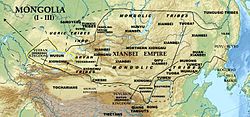
Back Yueban xaqanlığı AZ یوبان خاقانلیغی AZB Юебан Bulgarian Čolové Czech 悦般 Japanese Юебан мемлекеті KK Юэбань MN Юэбань Russian زابىندىر خانلىقى (يۆبەن ئېلى) UG Юебань Ukrainian
Yueban | |
|---|---|
| 160–490 | |
 | |
| Historical era | 1st millennium |
• Established | 160 |
• Disestablished | 490 |
| Today part of | Kazakhstan |
Yueban (Chinese: 悅般) (Middle Chinese: */jiuᴇt̚-pˠan/ < Late Han Chinese: */jyat-pɑn/[1]), colloquially: "Weak Xiongnu", was the name used by Chinese historians for remnants of the Northern Xiongnu[2] in Zhetysu, now part of modern-day Kazakhstan. In Chinese literature they are commonly called Yueban. The Yuebans gained their own visibility after disintegration of the Northern Xiongnu state, because unlike the main body of the Northern Xiongnu, who escaped from the Chinese sphere of knowledge, the Yueban tribes remained closer to China.
The Yueban emerged after the disintegration of the Xiongnu confederation. About 480s, the Yueban split into four Chuy tribes:[3] Chuyue (處月), Chumi (處密), Chumukun (處木昆), and Chuban (處半).
One Yueban branch, Chuyue, later intermixing with Göktürks, formed the Shatuo of the Western Göktürk Khaganate.[4] The Yueban-descended Shatuo played an important role in Chinese dynastic history. In the 10th century the remaining Shatuo branch of the Chuy tribe possibly joined Mongolic-speaking Tatar confederation in the territory of the modern Mongolia, and became known as Ongud or White Tatars[5][6] branch of the Tatars.
Another Yueban-descended tribe, Chumukun, might be associated with the Kimek confederation.
- ^ Schuessler, Axel. 2007. An Etymological Dictionary of Old Chinese. University of Hawaii Press. p. 586, 155
- ^ Book of Wei. Vol. 102. "悅般國,在烏孫西北,去代一萬九百三十里。其先,匈奴北單于之部落也。" Tr. "Yueban State is to the northwest of Wusun, at a distant of 10,930 lĭ from Dai. It formerly [was] the Northern Xiongnu chanyu's tribe."
- ^ Gumilev L.N., "Ancient Türks", Moscow, 'Science', 1967, Ch.20 http://gumilevica.kulichki.net/OT/ot20.htm (In Russian)
- ^ C. P. Atwood, Encyclopedia of Mongolia and the Mongol Empire, p.424
- ^ Ozkan Izgi, "The ancient cultures of Central Asia and the relations with the Chinese civilization"//The Turks, Ankara, 2002, p. 98, ISBN 975-6782-56-0
- ^ Paulillo, Mauricio. "White Tatars: The Problem of the Öngũt conversion to Jingjiao and the Uighur Connection" in From the Oxus River to the Chinese Shores: Studies on East Syriac Christianity in China and Central Asia (orientalia - patristica - oecumenica) Ed. Tang, Winkler. (2013) pp. 237-252